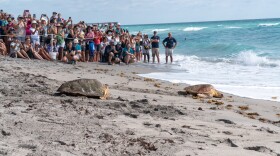-
Pennywise, weighing 302 pounds, was deemed healthy and strong enough to return to the wild Wednesday after being treated by Loggerhead Marinelife Center’s veterinary team over the past few months.
-
The "race" project stopped on Coquina Beach South in Bradenton, where the large turtle was tagged. Overall, 11 nesting reptiles will be monitored to track which one travels the farthest over three months.
-
The turtle was too big to get a CT scan on a human machine, so the team headed to an equine clinic and had the scan performed on equipment designed for horses.
-
This year's sea turtle nesting season is going great, with a leatherback on Sanibel and early nesting throughout the region. But few turtle lovers forget last season when early signs were record-breaking but the season's results were heart-breaking.
-
So far this week, the Sanibel-Captiva Conservation Foundation has documented 554 loggerhead nests and 1 leatherback nest on Sanibel and Captiva Islands -- 422 nests on Sanibel and 133 nests on Captiva.
-
The female turtle was struck by a car early Wednesday morning. She died from her injuries a short time later.
-
One of the turtles, Cayman, arrived at the center on Feb. 6, in need of surgery to repair a front left flipper that had become entangled in fishing line. The other, named Finley, had a fishing hook embedded in his shoulder when he arrived on April 27 and went through a round of antibiotics.
-
The record-setting start to 2023’s nesting season was real, but extreme weather events linked to climate change ending in a sad and bleak reproductive cycle.
-
Each year, between May and October, threatened and endangered sea turtles create their nests along Pinellas County's beaches.
-
Despite the large numbers, biologists say turtles face threats from such factors as reduced beaches as sea levels rise, and and more powerful tropical storms.
-
More than 1,000 loggerhead nests were counted on Sanibel and Captiva islands. Research shows Sanibel is averaging about five times more loggerhead nests compared to the 1970s and ‘80s.
-
The sea turtle nesting season that started just months after Ian hit ended up setting records for loggerhead turtles on Sanibel and Captiva island.
Play Live Radio
Next Up:
0:00
0:00
Available On Air Stations








